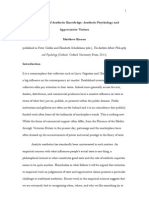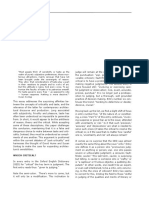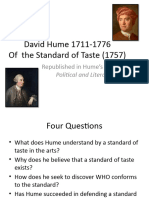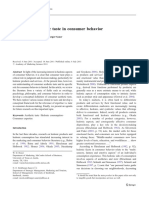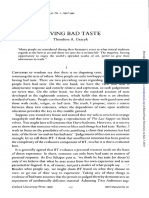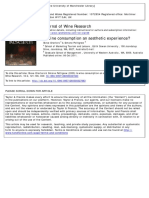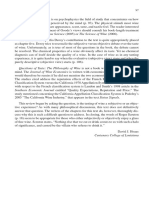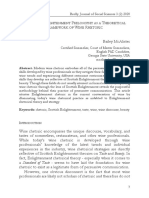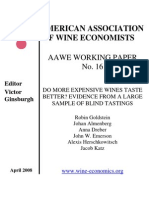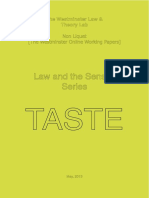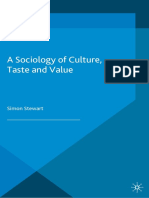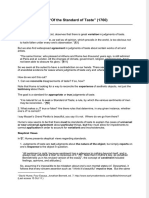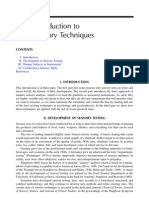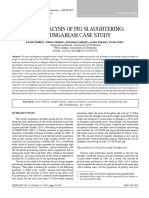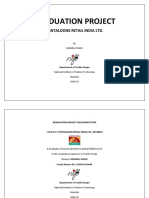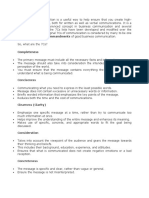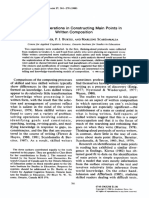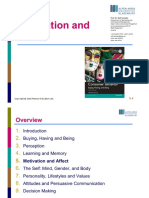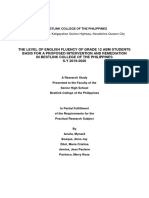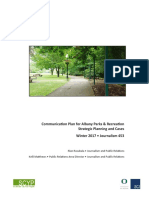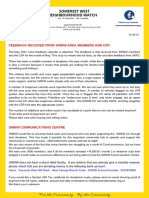A Matter of Taste: Evaluating The Quality of Qualitative Research
Uploaded by
CrocsA Matter of Taste: Evaluating The Quality of Qualitative Research
Uploaded by
CrocsNursing Inquiry 2015; 22(2): 86–94
Feature
A matter of taste: evaluating the
quality of qualitative research
Margarete Sandelowski
University of North Carolina at Chapel Hill School of Nursing, Chapel Hill, NC, USA
Accepted for publication 1 August 2014
DOI: 10.1111/nin.12080
SANDELOWSKI M. Nursing Inquiry 2015; 22: 86–94
A matter of taste: evaluating the quality of qualitative research
Driven by an impetus to standardize, numerous checklists have been devised to address quality in qualitative research, but these
standards and the mindset driving them offer no language with which to speak about taste, or the aesthetic sensibilities that play
such a key role in evaluating the goodness of any object. In this article, quality appraisal in qualitative research is considered in
the context of taste, that is, in the discernment involved in judging the value of research and in the recognition of the key role
reviewer preferences, sensibilities and membership in one or more taste communities play in these judgements. The evaluation
of a study is accomplished by evaluating one or more reports from that study, and such reports may be conceived as art forms
amenable to the same criteria for appraisal as poems or paintings. Taste implies judgements about the quality of objects and a
person’s ability to sift through and select from a store of knowledge that knowledge appropriate to judge its value. What binds a
community of practitioners (here reviewers of qualitative studies) together is taste-making, or the constant refinements of judge-
ments concerning what constitutes good and bad practice.
Key words: qualitative research, quality criteria, reliability, taste, validity.
A couple of years ago I came across an article by Jewell and artistic matters’ (Ollivier and Fridman 2001). Although
Bero (2008) entitled Developing good taste in evidence: Facilita- Jewell and Bero (2008, 204) never addressed taste per se,
tors of and hindrances to evidence-informed health policymaking in they implied a connection between good taste and evidence-
state government. I was immediately attracted to the word taste based skills training, concluding that:
in the title because at first it seemed so unusual to link a sen-
Skills training could help policymakers and their aides not
sibility commonly associated with clothes or wine to some- only identify relevant research but also distinguish research
thing so substantial as evidence. Yet as I thought about it of high and low methodological quality . . . such training
more, taste seemed to capture what I have long believed to could help them develop “good taste in evidence” [quota-
tions in original].
be insufficiently acknowledged in the voluminous literature
on quality criteria in qualitative research, namely the aes- This reference to taste ultimately led me to social science
thetic sensibilities that play such a key role in evaluating studies of taste (e.g. Bourdieu 1984; Fenster 1991; Lieberson
objects of any kind, whether consumer goods, works of art or 2000; Hennion 2007; Arsel and Bean 2013) and thereby to
works of science. Taste generally refers to a cultivated skill in another way to think about the evaluation of quality in
making ‘discriminating judgements about aesthetic and research and in qualitative research in particular. In this arti-
cle, I consider quality in qualitative research in the context
of taste, that is, in the discernment involved in judging the
Correspondence: Margarete Sandelowski, University of North Carolina at Chapel value of research and in the recognition of the key roles
Hill School of Nursing, 7460 Carrington Hall, Chapel Hill, NC 27599, USA.
reviewer preferences, sensibilities and membership in one or
E-mail: <msandelo@email.unc.edu>
more taste communities play in these judgements. Drawing
Category of article: Advancement of methodological approaches and frameworks from Eisner’s (1975, 1979, 1985, 1998, 2003) work, I
to enrich and extend the capacity of nursing and healthcare inquiry. consider connoisseurship and criticism as ‘practices of taste’
© 2014 John Wiley & Sons Ltd
Taste in qualitative research
(Elliott 2006, 229). For Eisner (1975, 8), ‘connoisseurship is Fridman 2001). Tastes are shaped in sociocultural and socio-
the art of appreciation [while] criticism is the art of disclo- historical contexts; there are diverse standards of taste and
sure’ of what one has appreciated or grasped about an ‘taste cultures [or] clusters of cultural forms which embody
object. similar values and aesthetic standards’ (Ollivier and Fridman
Although taste plays a role in the evaluation of any object 2001).
including quantitative research, I focus here on qualitative
research as artfulness is much more front and center in qual- Criteria for differentiating good from bad
itative than in quantitative research discourse. Consider, for taste
example, the move to arts-based modes of disseminating
qualitative research findings (e.g. Keen and Todres 2007; Arguing that too much of the sociology of taste had empha-
Boydell et al. 2012), the rise of I- or auto-ethnographic sized the ‘role of taste judgments as mechanisms of social
research that moves the researcher to the center of inquiry and cultural power, as distinctive markers of social position,
and seeks to ‘disrupt the binary of science and art’ (Ellis, or . . . as implicated in the reproduction of social inequality’,
Adams and Bochner 2011; parag. 39), and the emphasis Woodward and Emmison (2001, 295) sought to examine
given in the qualitative research literature to aesthetics, crea- taste at the level of individual actors by studying the criteria
tivity, elegance of expression, emotion, empathy, reflexivity, 619 Australians used for differentiating between good and
resonance, sincerity and vividness (e.g. Sandelowski 1994, bad taste. They found three domains by which respondents
1995, 2003; Eisner 1998; Watts 2008; Stige, Malterud and classified ‘objects, behaviors, attitudes, or aspects of self-pre-
Midtgarden 2009; Watson 2009; Tracy 2010; Ravenek and sentation [as] . . . tasteful or tasteless’ (302): quantity, com-
Laliberte Rudman 2013). Taste appears integral to the doing position and quality. An object of evaluation was deemed
and appraising of qualitative research as it is difficult here to tasteful in the domain of quantity to the extent that it had
separate the scientific/technical evaluation of the validity of the correct amount of something, such as the right amount
research procedures and results from the artistic evaluation of color in clothing, the right amount of food on a plate and
of the quality of the presentation of those procedures and in general the knowledge of when enough was enough; taste-
results. Indeed, this entanglement is largely due to the fact ful objects showed restraint and simplicity over ostentatious-
that validity in qualitative research is defined in part by what ness and gaudiness. An object was deemed tasteful in the
its dissemination vehicle (most typically the peer-reviewed domain of composition when it looked right, or when things
research report) evokes and provokes in its audiences. went together well showing harmony and balance as
opposed to showing elements that clashed or were mis-
A MERE TASTE OF THE SCHOLARSHIP ON matched. Finally, an object of evaluation was deemed tasteful
TASTE in the domain of quality to the extent that it showed ele-
gance and timelessness; such objects were considered classic.
Taste refers to the ability to be discriminating about some Woodward and Emmison (2001) found also that when
object of evaluation. Individuals are considered to have good respondents described good taste, they were more likely to
taste to the extent that they show a cultivated or educated use personal and/or aesthetic judgements, but when they
eye, ear or feeling for an object among other objects of its described bad taste, they were more likely to draw from col-
kind. A ‘good eye . . . pays attention’ (Rose 2012, 52); it looks lective or social norms. Respondents found judgements of
for and sees as opposed to merely looking at and thus bad taste (what I do not like) easier to express than judge-
requires a great deal of knowledge relevant to the object ments of good taste (what I like). Woodward and Emmison
(Eisner 1975, 1979). Taste is a cultivated faculty rather than (2001) emphasized the ‘socialness of taste judgements’
‘an innate disposition’ (Ollivier and Fridman 2001). (312) evident in ‘positioning one’s personal taste within the
Taste implies a judgement not only about the quality of range of acceptable social practice’ (313), concluding that
objects to be appraised but also about a person’s ability to there existed a ‘strong collective sentiment in definitions of
appraise: to sift through and select from among many taste’ (314), or an effort to discipline the self to fit in.
objects those of a kind and then—from a store of knowledge
—that knowledge appropriate to judge its value. As Bour- Taste as practice
dieu (1984, 6) is often quoted as saying: ‘Taste classifies, and
it classifies the classifier’. Taste is a component of the social Also suggesting that the sociology of taste had given too
process by which individuals ‘classify people, practices, and much primacy to socioeconomic distinctions, Gherardi
things into categories of unequal value’ (Ollivier and (2009, 535) sought to link taste to practices of all kinds by
© 2014 John Wiley & Sons Ltd 87
M Sandelowski
proposing that what bound a community of practitioners (2009) checklist for healthcare intervention studies. Numer-
together was ‘taste [or] a sense of what is aesthetically fitting’ ous checklists have been devised to address qualitative
in that community. Defining ‘taste-making as a collective, research and the qualitative research components of mixed-
emergent discursive process that constantly refines prac- methods research (e.g. Hannes, Lockwood and Pearson
tices’, Gherardi (2009, 536) observed that it is the: 2010; Tracy 2010; Schou et al. 2012; Heyvaert et al. 2013),
including the Consolidated Criteria for Reporting Qualita-
Passionate attachment of a community of practitioners to
the object of their practice . . . [for example] belonging to a
tive Research (COREQ; Tong, Sainsbury and Craig 2007),
scientific community and gaining pleasure from a particu- the CASP (2013) and the Mixed Methods Appraisal Tool
larly brilliant article [that forms] the basis of taste-making, (MMAT; Pluye et al. 2009).
i.e. a collective achievement that allows practitioners to
Despite all of this activity, however, no consensus exists
appraise the various performances of their working practices
that, in being appraised and contested, are constantly on how to define or evaluate the diverse array of studies in
refined. the qualitative research domain and even on whether stan-
dards are possible or desirable. Although a criterion of sys-
For Gherardi (2009) taste-making ‘is a situated activity
tematic review reporting is that quality of primary studies is
that rests on learning and knowing how to appraise specific
addressed via standardized criteria, there is still some dis-
performances of a practice’ (538), and it is accomplished by
quiet concerning how to use such criteria (White 2001; Petti-
‘sharing a vocabulary for appraisal; crafting identities within
crew and Roberts 2003; Pawson 2006; Sandelowski and
epistemic communities; and refining performances’ (536).
Barroso 2007; Boeije, van Wesel and Alisic 2011). Even more
Taste-making may thus be viewed as another way conceptu-
important, the quality checklists that have been developed
ally to capture the ‘constant improvisation’ (546) character-
and increasingly used allow researchers to claim they have
izing expertise in the ‘ability to discriminate and to criticize’
addressed quality without actually having to resolve the prob-
based on knowledge but (drawing from Gadamer) ‘without
lems these tools raise. Among these problems are narrow
recourse to absolute principles’ (539). Referring to improvi-
conceptions of appraisal emphasizing censure and exclusion
sation in jazz, Gherardi (2009, 546) noted that ‘the repeti-
over understanding and inclusion; failure to accommodate
tion of practices is not mechanical, just as every execution of
the diversity in qualitative research; preoccupation with
the same piece of jazz is not identical to the previous one’.
method talk over the logic and substance of findings; and
the conflation of method claims with methods actually used
TASTE AND QUALITY IN QUALITATIVE and of procedural with interpretive or reporting adequacy
RESEARCH (Barbour 2001; Sandelowski and Barroso 2007; Hammersley
2008).
The very words often used in discourses concerning quality Regarding the diversity in qualitative research, Hammers-
in empirical research (e.g. good, bad, strong, weak, best evi- ley (2008, 167) observed:
dence, best practices) suggest judgements characterizing
taste. Indeed, scholars have noted that criteria of quantity, We are not so much faced with a set of clearly differentiated
qualitative approaches as with a complex landscape of vari-
quality, composition and beauty are used to evaluate works
able practice in which the inhabitants use a range of labels
of science and of art (Eisner 1985). (“ethnography,” “discourse analysis,” “life history work,”
Over the last three decades, the number of texts address- “narrative study,” “activity theory,” “interpretivism,” “feminist
ing quality (also referred to as rigor, credibility, trustworthi- standpoint epistemology,” “postmodernism,” and so on) in
diverse and open-ended ways in order to characterise their
ness, validity and the like) in qualitative research has orientation; and probably do this somewhat differently
increased exponentially. The rise of systematic review/ across audiences and occasions.
research synthesis in the health sciences, and of qualitative
and mixed-methods research synthesis in particular, has Thorne (2011) noted the serious differences between the
made even more urgent the quest for standardized quality inquiry imperatives and agendas of the health and social sci-
criteria equivalent to guidelines in quantitative studies, such ences, and Bleijenbergh, Korzilius and Verschuren (2011)
as the Strengthening the Reporting of Observational Studies proposed criteria specific to practice-oriented research.
in Epidemiology (STROBE Statement 2009) checklists for These discipline- and audience-specific variations in
cohort, case–control and cross-sectional studies; the Critical language and social mandates make the evaluation of
Appraisal Skills Program (CASP) checklists for observational qualitative studies an exercise in the discernment constitut-
and intervention studies (2013); and the PRISMA: Transpar- ing taste as reviewers must have a wide-ranging knowledge of
ent Reporting of Systematic Reviews and Meta-Analysis these differences to choose the appropriate quality criteria
88 © 2014 John Wiley & Sons Ltd
Taste in qualitative research
to evaluate studies. As Hammersley (2008, 160) further (Emden and Sandelowski 1998, 1999), limits the extent to
observed: which these judgements can be made fully transparent or
intelligible to others. In the end, it is a matter of judgement
the reliance on judgment is inevitable . . . [as] the task of
assessing quality in the context of any relatively complex whether a report of a qualitative study shows or even ought
activity cannot be sensibly reduced to the application of to show ‘sincerity’, ‘resonance’ or ‘meaningful coherence’
explicit, concrete and exhaustive indicators. Instead, formu- (Tracy 2010, 840), or ‘explanatory, interpretive or explica-
lations of criteria, in terms of relevant standards and consid-
tory adequacy’ (Lee 2014, 316). It is a matter of judgement
erations that might need to be taken into account, come out
of [emphasis in original] the process of judgment and are whether a sampling strategy was sufficiently described and
modified by it; to one degree or another. appropriately justified, whether the findings were explicitly
stated and whether data saturation was achieved or even
That is, the appropriate considerations for evaluation derive
needed to be addressed (Critical Appraisal Skills Pro-
from and are influenced by the constant refinement of
gramme: 10 questions to help you make sense of qualitative
practice that Gherardi (2009) described as constituting
research 2013). It is a matter of judgement – not an attribute
taste-making.
of method or of findings – whether transparency or objectiv-
In short, the process of judging inevitably entails the
ity has been demonstrated. In the end, it is a matter of judge-
active deployment of taste, or the selection of those con-
ment whether any set of standards has been sufficiently met,
siderations deemed applicable to any one object of evalua-
whether the authors of research reports can be trusted and
tion in addition to the continual (re)interpretation of
therefore whether the methods and findings they present
those considerations and their applicability to any other
are ‘trustworthy enough to act on and make decisions in line
comparable object of evaluation. The exercise of taste sim-
with’ (Tracy 2010, 843).
ply cannot be eliminated from the evaluation process as it
Far from embodying a ‘completely unacceptable relativ-
is ‘the process of thinking about how [any set of quality]
ism . . . that reduces knowledge to the level of merely . . .
criteria would apply in [any one] context and how [these
taste’ (Smith 1990, 179), taste is in fact central to and an
criteria] relate to one another [that] is a productive force
inescapable fact of any evaluation of quality. Yet quality
in the development of research practice’ (Hammersley
checklists and the mindset driving them largely do not take
2008, 160). In the course of developing a guide for read-
account of the aesthetic criteria that shape evaluations of
ing qualitative studies, Sandelowski and Barroso (2002)
works of science and of art. They offer no ‘vocabulary with
found that reviewers asked to use the guide showed rela-
which to speak about taste’ (Gherardi 2009, 546), or ‘the aes-
tively low inter-rater and intra-rater consistency in the cate-
thetic criteria that support what constitutes ‘a good practice’
gories of information they selected as most and least
or ‘a sloppy one’ and ‘a beautiful practice’ or ‘an ugly one’’
influential in their evaluations of five reports of studies,
within the diverse communities of qualitative research practi-
but did show reading/reviewing tendencies or preferences.
tioners (547). They therefore do not allow reviewers to
For example, one reviewer showed few preferences in her
refine taste or ‘draw distinctions of taste and to spread them
most influential rankings, but showed a preference for
through the community’ (547).
descriptions of human subjects’ issues as least influential.
A second reviewer ranked the presentation of the theoreti-
cal orientation to the target phenomenon studied as most TASTE AND READER/WRITER/TEXT
influential in one study but least influential in another. I INTERACTION
have found in my own reviewing that the presence or
absence of something I judged to be good in one report I Taste is integral to the evaluation of study quality if only
might judge to be poor in another. because reviewers do not evaluate studies per se, but rather
Just as method functions in qualitative research more to the ‘literary technology’ (Shapin 1984) or the stylized after-
stimulate analysis than to determine or constitute findings the-fact reconstruction of a study that constitutes the conven-
(Eakin and Mykhalovskiy 2003), so do quality checklists and tional scientific research report (Bazerman 1988). The con-
guidelines serve more as trigger devices to what might be duct of research is inescapably entangled with the craft of
considered relevant, not as rules to be slavishly followed in presenting the results of that research. As Sandelowski and
every case. Moreover, ‘the situated nature of [these] judge- Barroso (2002, 2007) proposed, the appraisal of a study is a
ment[s]’ (Hammersley 2008, 165), in addition to a host literary in addition to a scientific enterprise as the research
of differences within and across research domains and report is no less an art form than the poem, novel or play.
disciplines regarding the ‘good’ and the ‘bad’ in research Readers may be said to belong to ‘taste cultures’ (Gans
© 2014 John Wiley & Sons Ltd 89
M Sandelowski
1999) in their personal preferences for and in the commu- observed, ‘the sense of goodness and feelings of comfort
nal standards they adhere to concerning appropriate ways to readers experience reading the report of a study constitute
disseminate the outcomes of a study. A taste culture is ‘an the very judgements they make about the validity or trustwor-
interpretive community with shared preferences, dislikes thiness of the study itself’. Strati (2008, 233) noted in his
and criteria for good and bad taste’ (Kuipers 2006, 360). studies of organizations that it was often difficult to deter-
Readers have to know how to read reports written to appeal mine whether beautiful and good are being used as synonyms
to different taste cultures. Taste cultures may be differenti- for each other. Indeed, scientists and mathematicians have
ated by styles of presentation and by the taste criteria to long emphasized the central role of beauty in judging work
which they adhere, such as (following Woodward and Emmi- (Nisbet 1976; Chandrasekhar 1987; King 1992; Franzosi
son) judgements about the right amount of quotations in a 2004; Strati 2008; Brockman 2013), and Tufte’s (2006) Beau-
report (quantity criterion), whether there is a discernible tiful evidence embodies this enduring link between science
logic to the presentation of findings (composition criterion), and art, and the good and the beautiful.
and about the balance between description and interpreta- When readers read qualitative research reports, they are
tion (quality criterion). In a book review, Finchamp (2014, located on what Rosenblatt (1978/1994) described as a con-
404) observed: tinuum of reading anchored by ‘efferent’ and ‘aesthetic’
readings. Efferent reading refers to what readers take away
My sense is that how data is [sic] used and reported is as
from a text such as information and facts, or in the case of a
much a question of taste as anything. I, for one, enjoy
[emphasis added] seeing lots of data and being given the research report, methodological procedure and the findings
space by authors to do a little of the interpretative work of a study. Aesthetic reading refers to the reader’s relation-
myself.
ship and aesthetic experience with a particular text. Here
The systematic review/evidence-based practice community the reading is less about taking away information as it is
may be viewed as a taste culture with a strong preference for engaging with the experience of reading itself and such
standardization in reporting (a composition criterion). Taste things as the rhythms of the language or the prose style of a
cultures may also be defined by differences between the pref- text. Consider the emphasis placed in qualitative research
erence for closed-ended texts that strive to ‘fix meaning in on style, elegance of expression, the use of metaphor and
writing’ (Prasad 2005, 243) or for open-ended texts in which imagery, and the evocative qualities of a text, and on the
‘meaning is . . . never definitely fixed’ (Prasad 2005, 244) ‘sensual quality’ and ‘joys of crafting qualitative research’
and that strive to preserve and express complexity and the (Prasad 2005, 291).
‘multiplicity, ambiguity, and incoherent subjectivity’ in data
(Jackson and Mazzei 2012, 4). CONNOISSEURSHIP AS THE PRACTICE OF
Quality appraisal is therefore as much about reader/wri- TASTE
ter/text interactions as it is about the procedural aspects of a
project or validity of findings. As Golden-Biddle and Locke The practice of taste is embodied in connoisseurship, which
(1993, 597) observed: Eisner (1975, 6) defined as an ‘appreciative art. . . not neces-
sarily [entailing] a liking or preference for what one has
Reading is an interactive process in which readers not only
encountered, but rather an awareness of its characteristics
receive the text and its appeals to engage it and find it con-
vincing, but also act on the text to create interpretations. . . and qualities’ that derives from a wide stock of knowledge.
researchers . . .[must] convince readers that the findings are The word connoisseurship derives from the Latin word cognos-
credible. . .[while] . . .readers [must] convince themselves
cere (to know). Eisner (1975, 6) offered an extended exam-
that the interpretations are credible and worth paying atten-
tion to. ple of the wine connoisseur who ‘through long and careful
attention to wine’ has developed a ‘palate that enables him
For example, according to Golden-Biddle and Locke (sic) to discern its most subtle qualities’.
(1993, 598), convincing ethnographic texts have to gener-
ate in the reader ‘a particular balance of novelty and When he [sic] drinks wine it is done with an intention to dis-
cern, and with a set of techniques that he employs to
familiarity’.
examine the range of qualities within the wine upon which
The judgement that findings are credible lies at least as he will make his judgments. Body, color, nose, aftertaste,
much in how well they appeal and even bring joy to the read- bite, flavor, these are some of the attributes to which the
wine connoisseur attends. In addition, he brings to bear
ers in a variety of taste cultures as it does in the correspon-
upon his present experience a gustatory memory of other
dence of these findings to something true about the target wines tasted. These other wines, held in the memory, form
phenomena studied. Sandelowski and Barroso (2007, xix) the backdrop for his present experience with a particular
90 © 2014 John Wiley & Sons Ltd
Taste in qualitative research
vintage. It is through his refined palate, his knowledge continually refined. Criticism ‘lift[s] the veils that keep the
of what to look for, his backlog of previous experience eyes from seeing by providing the bridge needed by others
with wines other than those he is presently drinking that
differentiates his level of discernment from that of an to experience the qualities’ the critic experienced (Eisner
ordinary drinker of wine. His conclusions about the 1975, 8–9).
quality of wines are judgments, not mere preferences.
Judgments, unlike preferences which are incorrigible, can
be grounded in reasons, reasons that refer back to CONCLUSION
the wines’ qualities and to other wines of the same variety
(Eisner 1975, 6–7). Connoisseurship in assessing the quality of qualitative
research is not the mindless consumption of any single set of
According to Eisner (1975, 8), more complex objects such as criteria but rather the selection from a stock of knowledge
the fine arts and literature require even more connoisseur- and prior experience with studies those considerations rele-
ship as they ‘require an ability to recognize both how and vant to the study at hand. Critics communicate those judge-
why they depart from conventional modes in their respective ments in their reviews and thereby contribute to the
art forms’. continual refinement of taste in their respective communi-
Applying Eisner’s description of wine connoisseurship to ties of practice.
connoisseurship in the appraisal of qualitative research, The evaluation of the quality of qualitative research is to
when a reviewer evaluates a study, s/he does it with an inten- a significant extent a matter of taste whether we researchers
tion to discern, and with a set of techniques that s/he like it or not. ‘Positioned, perspectival human judgement’
employs to examine the range of qualities evident in the (Orr 2010, 16) situated within communities of practice is
report of that study upon which s/he will make her/his judg- central to the evaluation of empirical research, but this does
ements. The structure and logic of the presentation, the par- not mean that such judgement is totally arbitrary or without
allelism of comparisons, the judicious use of quotations and any recourse to principles. In her study of faculty conduct-
cases, the expressiveness of metaphors and imagery used, ing student assessments in the fine arts, Orr (2010) offered
the empathic feelings induced, the reflexivity shown, the res- an explanation that might be applicable to why members of
onance of findings with personal experience and ‘the her- qualitative research communities of practice might feel
meneutical aesthetics of thick description’ (Freeman 2014), much discomfort acknowledging the role that connoisseur-
these are some of the attributes to which the qualitative ship as a taste practice plays in quality evaluation. According
research connoisseur attends. In addition, s/he brings to to Orr, the idea of connoisseurship appears to contradict
bear upon her/his present experience a memory of other the aim of transparency, that is, to make evaluation pro-
studies evaluated. These other studies form the backdrop for cesses and criteria explicit and clear. Transparency is a
her/his present experience with a particular type of study. It much used term in discourses about the validity of research
is through her/his refined eye and sensibilities, knowledge procedures and findings, but integral to the taste-making of
of what to look for, backlog of previous experience with stud- the connoisseur is the impossibility of transparency, of artic-
ies other than the one s/he is presently reviewing that differ- ulating or accounting for all aspects of one’s engagement
entiates her/his level of discernment from that of an with an object. Moreover, transparency is itself not an attri-
ordinary reader. The reviewer’s conclusions about the qual- bute of any inquiry procedure but rather a judgement
ity of studies are judgements grounded in reasons that refer made about its clarity and whether clarity ought to be
back to studies’ qualities and to other studies of the same judged at all.
kind, not mere preferences. The reviewer is able to recog- A commonplace idiomatic expression is that there is no
nize both how and why a study and the report of that study accounting for taste. Yet the evaluation of qualitative
might depart from conventional or prevailing modes of con- research calls for some effort to account for the role taste
duct and dissemination. plays: to articulate the aesthetic sensibilities that hold differ-
For Eisner (1975, 8), whereas connoisseurship is the ent communities of practice together and to acknowledge
private art of appreciation, criticism is the public art of the taste-making that is tacit in any appraisal human beings
disclosure ‘in linguistic terms of what it is that [the critic] make.
has encountered so that others not possessing his [sic] level
of connoisseurship can also enter into the work’. Eisner ACKNOWLEDGEMENTS
viewed the function of criticism as educational, which is com-
parable to Gherardi’s (2009) view of the vocabulary shared A previous version of this article–‘Developing taste in qualita-
by a community of practitioners by which taste is taught and tive research’—was delivered as a keynote address at the
© 2014 John Wiley & Sons Ltd 91
M Sandelowski
19th Annual Qualitative Health Research Conference in Consortium, Department of Education, Stanford
Halifax, Nova Scotia on October 29, 2013. University. http://www.eric.ed.gov/PDFS/ED128408.pdf
(accessed 28 August 2014).
REFERENCES Eisner EW. 1979. The educational imagination. New York, NY:
Macmillan.
Arsel Z and J Bean. 2013. Taste regimes and market-medi- Eisner EW. 1985. Aesthetic modes of knowing. In Learning
ated practice. Journal of Consumer Research 39: 899–917. and teaching the ways of knowing: Eighty-fourth yearbook of the
Barbour RS. 2001. Checklists for improving rigor in qualita- National Society for the Study of Education, ed. E Eisner, Part
tive research: A case of the tail wagging the dog? British II, 23–36. Chicago: National Society for the Study of Edu-
Medical Journal 322: 1115–7. cation.
Bazerman C. 1988. Shaping written knowledge: The genre and Eisner EW. 1998. The enlightened eye: Qualitative inquiry and the
activity of the experimental article in science. Madison, WI: enhancement of educational practice. Upper Saddle River,
University of Wisconsin Press. NJ: Merrill.
Bleijenbergh I, H Korzilius and P Verschuren. 2011. Method- Eisner EW. 2003. Artistry in education. Scandinavian Journal
ological criteria for the internal validity and utility of of Educational Research 47: 373–84.
practice oriented research. Quality & Quantity 45: 145– Elliott C. 2006. Considering the connoisseur: Probing the
56. language of taste. Canadian Review of American Studies 36:
Boeije HR, F van Wesel and E Alisic. 2011. Making a differ- 229–36.
ence: Towards a method for weighing the evidence in a Ellis C, TE Adams and AP Bochner. 2011. Autoethnography:
qualitative synthesis. Journal of Evaluation in Clinical Prac- An overview. Forum: Qualitative Social Research 12:1,
tice 17: 657–63. Art. 10, 40 paragraphs. http://nbn-resolving.de/urn:
Bourdieu P. 1984. Distinction: A social critique of the judgment of nbn:de:0114-fqs1101108 (accessed 20 July 2014).
taste. trans. R Nice. Cambridge, MA: Harvard University Emden C and M Sandelowski. 1998. The good, the bad, and
Press. the relative, part 1: Conceptions of goodness in qualita-
Boydell KM, BM Gladstone, T Volpe, B Allemang and tive research. International Journal of Nursing Practice 4:
E Stasiulis. 2012. The production and dissemination of 206–12.
knowledge: A scoping review of arts-based health Emden C and M Sandelowski. 1999. The good, the bad, and
research. Forum: Qualitative Social Research, 13:1, Art. the relative, part 2: Goodness and the criterion problem
32, 40 paragraphs. http://nbn-resolving.de/urn:nbn: in qualitative research. International Journal of Nursing
de:0114-fqs1201327 (accessed 21 May 2014). Practice 5: 2–7.
Brockman J. 2013. This explains everything: Deep, beautiful, and Fenster M. 1991. The problem of taste within the problem-
elegant theories of how the world works. New York, NY: Har- atic of culture. Communication Theory 1: 87–105.
perCollins. Finchamp B. 2014. Book review: Joshua I. Newman and
Chandrasekhar S. 1987. Truth and beauty: Aesthetics and Michael D. Giardina, Sport, Spectacle, and NASCAR
motivations in science. Chicago: University of Chicago Nation: Consumption and the Cultural Politics of Neolib-
Press. eralism. Qualitative Research 14: 403–4.
Critical Appraisal Skills Programme: 10 questions to help Franzosi R. 2004. From words to numbers: Narrative, data,
you make sense of qualitative research. 2013. http:// and social science. New York, NY: Cambridge University
media.wix.com/ugd/dded87_951541699e9edc71ce66c9- Press.
bac4734c69.pdf (accessed 20 July 2014). Freeman M. 2014. The hermeneutical aesthetics of thick
Critical Appraisal Skills Programme: Making sense of evi- description. Qualitative Inquiry 20: 827–33.
dence. 2013. http://www.casp-uk.net/find-appraise-act/ Gans H. 1999. Popular culture and high culture: An analysis and
appraising-the-evidence/ (accessed 20 July 2014). evaluation of taste, revised and updated. New York, NY: Basic
Eakin JM and E Mykhalovskiy. 2003. Reframing the evalua- Books.
tion of qualitative health research: Reflections on a Gherardi S. 2009. Practice? It’s a matter of taste!. Management
review of appraisal guidelines in the health sciences. Jour- Learning 40: 535–50.
nal of Evaluation in Clinical Practice 9: 187–94. Golden-Biddle K and K Locke. 1993. An investigation of how
Eisner EW. 1975. The perceptive eye: Toward the reforma- ethnographic texts convince. Organization Science 4: 595–
tion of educational evaluation. Stanford Evaluation 616.
92 © 2014 John Wiley & Sons Ltd
Taste in qualitative research
Hammersley M. 2008. The issue of quality in qualitative Petticrew M and H Roberts. 2003. Evidence, hierarchies, and
research. In Questioning qualitative inquiry: Critical essays, typologies: Horses for courses. Journal of Epidemiology &
ed. M Hammersley, 158–79. Los Angeles: Sage. Community Health 57: 527–9.
Hannes K, C Lockwood and A Pearson. 2010. A comparative Pluye P, M-P Gagnon, F Griffiths and J Johnson-Lafleur.
analysis of three online appraisal instruments’ ability to 2009. A scoring system for appraising mixed methods
assess validity in qualitative research. Qualitative Health research, and concomitantly appraising qualitative, quan-
Research 20: 1736–43. titative and mixed methods primary studies in mixed
Hennion A. 2007. Those things that hold us together: Taste studies reviews. International Journal of Nursing Studies 46:
and sociology. Cultural Sociology 1: 97–114. 529–46.
Heyvaert M, K Hannes, B Maes and P Onghena. 2013. Criti- Prasad P. 2005. Crafting qualitative research: Working in the post-
cal appraisal of mixed methods studies. Journal of Mixed positivist traditions. Armonk, NY: M.E.Sharpe.
Methods Research 7: 302–27. PRISMA: Transparent Reporting of Systematic Reviews and
Jackson AY and LA Mazzei. 2012. Thinking with theory in quali- Meta-Analysis. 2009. http://www.prisma-statement.org/
tative research: Viewing data across multiple perspectives. Lon- statement.htm (accessed 20 July 2014).
don: Routledge. Ravenek MJ and D Laliberte Rudman. 2013. Bridging
Jewell CJ and LA Bero. 2008. “Developing good taste in conceptions of quality in moments of qualitative
evidence”: Facilitators of and hindrances to evidence- research. International Journal of Qualitative Methods 12:
informed health policymaking in state government. 436–56.
Milbank Quarterly 86: 177–208. Rose G. 2012. Visual methodologies: An Introduction to researching
Keen S and L Todres. 2007. Strategies for disseminating with visual materials, 3rd ed.. London, UK: Sage.
qualitative research findings: Three exemplars. Forum: Rosenblatt IM. 1978/1994. The reader, the text, the poem: The
Qualitative Social Research, 8(3), Art. 17, 36 paragraphs. transactional theory of the literary work, with new preface and
http://nbn-resolving.de/urn:nbn:de:0114-fqs0703174 epilogue. Carbondale, IL: Southern Illinois University
(accessed 28 August 2014). Press.
King JP. 1992. The art of mathematics. New York: Fawcett Col- Sandelowski M. 1994. The proof is in the pottery: Toward a
umbine. poetic for qualitative inquiry. In Critical issues in qualitative
Kuipers G. 2006. Television and taste hierarchy: The case of research methods, ed J Morse, 46–63. Thousand Oaks, CA:
Dutch television comedy. Media Culture & Society 28: 359– Sage.
78. Sandelowski M. 1995. On the aesthetics of qualitative
Lee J. 2014. Genre-appropriate judgments of qualitative research. Image: Journal of Nursing Scholarship 27:
research. Philosophy of the Social Sciences 44: 316–48. 205–9.
Lieberson S. 2000. A matter of taste: How names, fashion and Sandelowski M. 2003. Tables or tableaux? Writing and read-
culture change. Cambridge, MA: Harvard University ing mixed methods studies. In Handbook of mixed methods
Press. in social and behavioral research, eds A Tashakkori and C
Nisbet R. 1976. Sociology as an art form. New York: Oxford Teddlie, 321–50. Thousand Oaks, CA: Sage.
University Press. Sandelowski M and J Barroso. 2002. Reading qualitative stud-
Ollivier M and V Fridman. 2001. Taste/taste culture. In Inter- ies. International Journal of Qualitative Methods, 1:1, Article
national encyclopedia of the social & behavioral sciences, eds 5. http://ejournals.library.ualberta.ca/index.php/
NJ Smelser and PB Baltes, 15442–7. United Kingdom: IJQM/issue/view/385 (accessed 21 May 2014).
Elsevier Science. http://educ.jmu.edu/~brysonbp/sym- Sandelowski M and J Barroso. 2007. Handbook for synthesizing
bound/papers2001/Olivier.html (accessed 31 July qualitative research. New York, NY: Springer.
2014). Schou L, H Høstrup, EE Lyngsø, S Larsen and I Poulsen.
Orr S. 2010. ‘“We kind of try to merge our own experience 2012. Validation of a new assessment tool for qualita-
with the objectivity of the criteria”: The role of connois- tive research articles. Journal of Advanced Nursing 68:
seurship and tacit practice in undergraduate fine art 2086–94.
assessment. Art, Design & Communication in Higher Educa- Shapin S. 1984. Pump and circumstance: Robert Boyle’s
tion 9: 5–19. literary technology. Social Studies of Science 14: 481–520.
Pawson R. 2006. Digging for nuggets: How ‘bad’ research Smith JK. 1990. Alternative research paradigms and the
can yield ‘good’ evidence. International Journal of Social problem of criteria. In The paradigm dialog, ed EG Guba,
Research Methodology 9: 127–42. 167–87. Newbury Park: Sage.
© 2014 John Wiley & Sons Ltd 93
M Sandelowski
Stige B, K Malterud and T Midtgarden. 2009. Toward an Tracy SJ. 2010. Qualitative quality: Eight “big-tent” criteria
agenda for evaluation of qualitative research. Qualitative for excellent qualitative research. Qualitative Inquiry 16:
Health Research 19: 1504–16. 837–51.
Strati A. 2008. Aesthetics in the study of organizational life. Tufte ER. 2006. Beautiful evidence. Cheshire, CT: Graphics
In The Sage handbook of new approaches in management and Press LLC.
organization, eds D Barry and H Hansen, 229–38. Lon- Watson C. 2009. The “impossible vanity”: Uses and abuses of
don, UK: Sage. empathy in qualitative inquiry. Qualitative Research 9:
STROBE Statement. 2009. Strengthening the reporting of 105–17.
observational studies in epidemiology. http://www. Watts JH. 2008. Emotion, empathy and exit: Reflections on
strobe-statement.org/?id=available-checklists (accessed doing ethnographic qualitative research on sensitive top-
20 July 2014). ics. Medical Sociology Online 3: 3–14.
Thorne S. 2011. Toward methodological emancipation in White DG. 2001. Evaluating evidence and making judgments
applied health research. Qualitative Health Research 21: of study quality: Loss of evidence and risks to policy and
443–53. practice decisions. Critical Public Health 11: 3–17.
Tong A, P Sainsbury, J Craig. 2007. Consolidated criteria for Woodward I and M Emmison. 2001. From aesthetic princi-
reporting Qualitative research (COREQ): A 32-item ples to collective sentiments: The logics of everyday judg-
checklist for interviews and focus groups. International ments of taste. Poetics 29: 295–316.
Journal for Quality in Health Care 19: 349–57.
94 © 2014 John Wiley & Sons Ltd
Copyright of Nursing Inquiry is the property of Wiley-Blackwell and its content may not be
copied or emailed to multiple sites or posted to a listserv without the copyright holder's
express written permission. However, users may print, download, or email articles for
individual use.
You might also like
- Discovering Quality or Performing Taste PDFNo ratings yetDiscovering Quality or Performing Taste PDF23 pages
- Before Price Educated Tastes Extended Version Download100% (12)Before Price Educated Tastes Extended Version Download15 pages
- Hanquinet (2018) But Is It Good Why Aesthetic Values MatNo ratings yetHanquinet (2018) But Is It Good Why Aesthetic Values Mat13 pages
- Blackwell Publishing The American Society For AestheticsNo ratings yetBlackwell Publishing The American Society For Aesthetics14 pages
- The Fragility of Aesthetic Knowledge: Aesthetic Psychology and Appreciative Virtues Matthew KieranNo ratings yetThe Fragility of Aesthetic Knowledge: Aesthetic Psychology and Appreciative Virtues Matthew Kieran20 pages
- Wine Consumption: An Aesthetic Experience?No ratings yetWine Consumption: An Aesthetic Experience?17 pages
- Cottish Nlightenment Hilosophy As A Heoretical Ramework of INE HetoricNo ratings yetCottish Nlightenment Hilosophy As A Heoretical Ramework of INE Hetoric11 pages
- Expression and Objectivity in The Case of Wine - Defending The Aesthetic Terroir of Tastes and SmellsNo ratings yetExpression and Objectivity in The Case of Wine - Defending The Aesthetic Terroir of Tastes and Smells16 pages
- A Very Short, Fairly Interesting and Reasonably Cheap Book About Qualitative Research - David SilvermanNo ratings yetA Very Short, Fairly Interesting and Reasonably Cheap Book About Qualitative Research - David Silverman228 pages
- Taste Versus The Market: An Extension of Research On The Consumption of Popular CultureNo ratings yetTaste Versus The Market: An Extension of Research On The Consumption of Popular Culture11 pages
- Making The Multi Dimensional Taste of JapanNo ratings yetMaking The Multi Dimensional Taste of Japan13 pages
- Modesto Gayo-Cal, and David Wright. London and New York: Routledge, 2009. 311pp. $?No ratings yetModesto Gayo-Cal, and David Wright. London and New York: Routledge, 2009. 311pp. $?3 pages
- Learning To Become A Taste Expert: Kathryn A. Latour John A. DeightonNo ratings yetLearning To Become A Taste Expert: Kathryn A. Latour John A. Deighton55 pages
- The Expansion of Taste in The Course of HistoryNo ratings yetThe Expansion of Taste in The Course of History20 pages
- The Objectivity of Taste Hume and Kant PDFNo ratings yetThe Objectivity of Taste Hume and Kant PDF19 pages
- Food Quality and Preference: Marion Mouret, Grégory Lo Monaco, Isabel Urdapilleta, Wendy V. ParrNo ratings yetFood Quality and Preference: Marion Mouret, Grégory Lo Monaco, Isabel Urdapilleta, Wendy V. Parr6 pages
- On The Qualia of Sensory Food Heritage in SingaporeNo ratings yetOn The Qualia of Sensory Food Heritage in Singapore19 pages
- Sociology of Culture, Taste and Value, A - Stewart, SimonNo ratings yetSociology of Culture, Taste and Value, A - Stewart, Simon205 pages
- Perspectives On Taste Aesthetics Language Metaphysics and Experimental Philosophy 1st Edition Jeremy Wyatt Online ReadingNo ratings yetPerspectives On Taste Aesthetics Language Metaphysics and Experimental Philosophy 1st Edition Jeremy Wyatt Online Reading109 pages
- Sensory Evaluation Lab Report: Taylor Zwimpfer Nutrition 205, Section 3 28 October 2013No ratings yetSensory Evaluation Lab Report: Taylor Zwimpfer Nutrition 205, Section 3 28 October 201326 pages
- Carl Wilson Celine Dions Lets Talk About Love - Ch8No ratings yetCarl Wilson Celine Dions Lets Talk About Love - Ch818 pages
- Cost Analysis of Pig Slaughtering: A Hungarian Case StudyNo ratings yetCost Analysis of Pig Slaughtering: A Hungarian Case Study10 pages
- Cost of Capital: - Importance From The Capital Budgeting DecisionsNo ratings yetCost of Capital: - Importance From The Capital Budgeting Decisions37 pages
- Fair Trade Coffee: Nicaragua to FinlandNo ratings yetFair Trade Coffee: Nicaragua to Finland14 pages
- Chemometric Discrimination of PhilippineNo ratings yetChemometric Discrimination of Philippine5 pages
- Analyzing The Game Narrative Structure ANo ratings yetAnalyzing The Game Narrative Structure A244 pages
- Bodybuilding Success Blueprint: The Big Three: By: Bill StarrNo ratings yetBodybuilding Success Blueprint: The Big Three: By: Bill Starr5 pages
- Bereiter & Scardamalia Cognitive Operations1988No ratings yetBereiter & Scardamalia Cognitive Operations198818 pages
- Inc Coach U Coach Us Essential Coaching Tools Your Complete Practice Resource 2005-2-210825 173252100% (2)Inc Coach U Coach Us Essential Coaching Tools Your Complete Practice Resource 2005-2-210825 173252542 pages
- National Labor Relations Commission: Manufacturing Corporation vs. Alcon and Papa, G.R. No. 194884, October 22, 2014)89% (9)National Labor Relations Commission: Manufacturing Corporation vs. Alcon and Papa, G.R. No. 194884, October 22, 2014)7 pages
- Grade III: Lesson Plan in English 2 and 3No ratings yetGrade III: Lesson Plan in English 2 and 35 pages
- Unit 1: Exercise 1: Complete The Table With These PhrasesNo ratings yetUnit 1: Exercise 1: Complete The Table With These Phrases11 pages
- Practical Research 2: Quarter 1 - Module 1No ratings yetPractical Research 2: Quarter 1 - Module 137 pages
- Somerset West Neighbourhood Watch: For The Community by The CommunityNo ratings yetSomerset West Neighbourhood Watch: For The Community by The Community2 pages
- My University, My Pride, My Future, My Affordable EducationNo ratings yetMy University, My Pride, My Future, My Affordable Education52 pages
- KVS PRT Question Paper-Watermark - pdf-91No ratings yetKVS PRT Question Paper-Watermark - pdf-9110 pages






